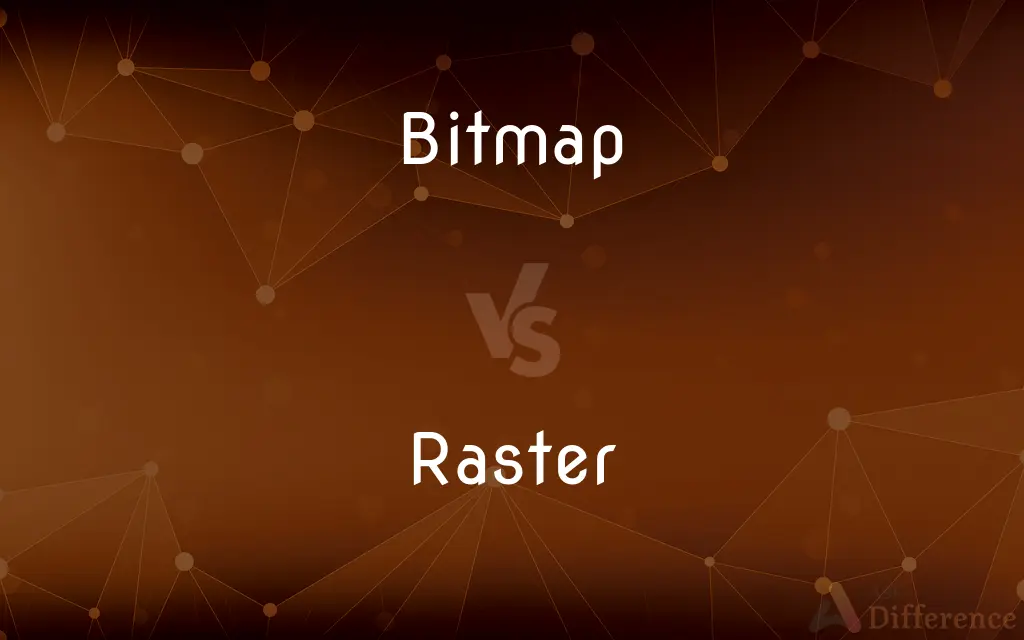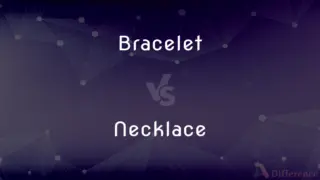Bitmap vs. Raster — What's the Difference?
By Tayyaba Rehman & Maham Liaqat — Updated on March 13, 2024
Bitmap and raster graphics are both pixel-based image formats, but "bitmap" often refers specifically to monochrome images, while "raster" encompasses all types of pixel-based images, including full-color.

Difference Between Bitmap and Raster
Table of Contents
ADVERTISEMENT
Key Differences
Bitmap images are a type of raster graphics, but they are specifically used to refer to images that are made up of pixels displayed in a grid format to represent an image. These images are often monochrome, using a single bit per pixel, which means each pixel can be either on or off. On the other hand, raster graphics are a broader category that includes bitmap images but also supports full-color images with multiple bits per pixel, allowing for a wide range of colors.
Bitmaps are typically used for simple images such as icons or glyphs because of their monochrome nature. They are highly efficient for images that require only two colors, making them ideal for text, simple illustrations, and other high-contrast images. Whereas, raster graphics are used for complex images such as photographs or detailed illustrations because they can represent millions of colors, making them suitable for images that require subtle gradations of color and detail.
The file size of a bitmap image is generally smaller than that of a color raster image because it contains less information per pixel. However, the file size of raster graphics can vary significantly based on the color depth and compression used. This means that while bitmaps can be more storage-efficient for simple images, raster images require more storage space to accommodate the greater color information.
When it comes to scalability, both bitmap and raster images face similar limitations. Enlarging these images often leads to pixelation, where the individual pixels become visible, making the image appear blurry or jagged. However, this issue is more pronounced in bitmap images due to their limited color information, whereas high-resolution raster images may still retain acceptable quality when moderately enlarged.
Despite their differences, both bitmap and raster images are crucial in digital imaging and graphic design. Bitmaps offer a simple, efficient way to represent monochrome images, while raster graphics provide the versatility needed for detailed and colorful imagery. The choice between them depends on the specific needs of the project, such as the desired image complexity, color requirements, and storage considerations.
ADVERTISEMENT
Comparison Chart
Color Depth
Typically monochrome (1 bit per pixel).
Can range from monochrome to full color (up to 32 bits per pixel).
Usage
Icons, glyphs, text.
Photographs, detailed illustrations.
File Size
Generally smaller for simple images.
Larger, depends on color depth and compression.
Scalability
Limited, pixelation occurs when enlarged.
Limited, but high-resolution images may retain more quality when enlarged.
Flexibility
Less flexible due to monochrome nature.
More flexible, supports a wide range of colors and details.
Compare with Definitions
Bitmap
A monochrome image format using a grid of black and white pixels.
The company logo was saved as a bitmap for the webpage.
Raster
An image format that uses pixels to represent visual details.
The photographer saved the image as a raster file for editing.
Bitmap
A digital image composed of a matrix of dots.
Bitmaps are ideal for creating simple icons.
Raster
A bitmap image that supports multiple colors.
Raster images are used for high-quality photo prints.
Bitmap
An image format with minimal color information.
The QR code is typically generated as a bitmap image.
Raster
A scalable image format with limitations due to pixelation.
When zooming in on a raster image, individual pixels become visible.
Bitmap
A representation of a binary image in computer graphics.
Bitmap fonts are used for text rendering in electronic devices.
Raster
An image type suitable for complex visuals.
He created a raster version of the logo to include gradients and shadows.
Bitmap
An image file format that stores pictures as arrays of pixels.
He used a bitmap to design the digital clock interface.
Raster
A digital image containing a grid of colored squares.
Raster graphics are preferred for detailed digital paintings.
Bitmap
In computing, a bitmap is a mapping from some domain (for example, a range of integers) to bits. It is also called a bit array or bitmap index.
Raster
A scanning pattern of parallel lines that form the image projected on a cathode-ray tube of a television set or display screen.
Bitmap
A set of bits that represents a graphic image, with each bit or group of bits corresponding to a pixel in the image.
Raster
(electronics) A scanning pattern of parallel lines that form the display of an image projected on a cathode-ray tube of a television set or display screen.
Bitmap
(computing) A series of bits that represents a rasterized graphic image, each pixel being represented as a group of bits.
Raster
(computer graphics) A bitmap image, consisting of a grid of pixels, stored as a sequence of lines.
Bitmap
An image represented as a two dimensional array of brightness values for pixels
Raster
To scan in parallel lines.
Raster
Formation consisting of the set of horizontal lines composed of pixels that is used to form an image on a CRT
Common Curiosities
What is a bitmap?
A bitmap is a type of digital image made up of pixels, often used for monochrome images.
How do bitmap and raster images differ?
Bitmaps are typically monochrome, using one bit per pixel, whereas raster images can include full-color imagery with multiple bits per pixel.
How does color depth affect file size?
Higher color depth increases file size as more information is stored for each pixel.
What are the limitations of scaling bitmap and raster images?
Both bitmap and raster images suffer from pixelation when enlarged, affecting image clarity.
Can raster graphics handle transparency?
Yes, raster graphics can handle transparency, allowing for complex image overlays.
What file formats are used for bitmap and raster images?
Bitmaps often use formats like BMP, while raster images can be saved in JPEG, PNG, or TIFF formats.
What are raster graphics?
Raster graphics are images that are made up of a grid of pixels, capable of displaying a wide range of colors.
Are all bitmap images black and white?
While traditionally monochrome, bitmaps can also include limited palettes using more bits per pixel.
Can raster images be converted to bitmap?
Yes, raster images can be converted to bitmap, usually by reducing the color depth to monochrome.
Why choose bitmap over raster?
Bitmaps are chosen for their simplicity and efficiency in representing monochrome images like text or icons.
Are bitmap images suitable for photographs?
No, bitmap images are not suitable for photographs due to their limited color range.
Can the quality of a bitmap image be improved?
Improving quality is limited; it's better to start with a higher resolution or switch to a raster format for more detailed images.
How do you choose between bitmap and raster for a project?
The choice depends on the project's needs, such as image complexity, color requirements, and storage constraints.
What tools are used to create raster graphics?
Tools like Adobe Photoshop and GIMP are popular for creating and editing raster graphics.
Is vector or raster better for web graphics?
It depends on the use case; vectors are better for scalability and simple designs, while rasters are better for detailed and complex images.
Share Your Discovery

Previous Comparison
Bracelet vs. Necklace
Next Comparison
Hook vs. ChorusAuthor Spotlight
Written by
Tayyaba RehmanTayyaba Rehman is a distinguished writer, currently serving as a primary contributor to askdifference.com. As a researcher in semantics and etymology, Tayyaba's passion for the complexity of languages and their distinctions has found a perfect home on the platform. Tayyaba delves into the intricacies of language, distinguishing between commonly confused words and phrases, thereby providing clarity for readers worldwide.
Co-written by
Maham Liaqat














































